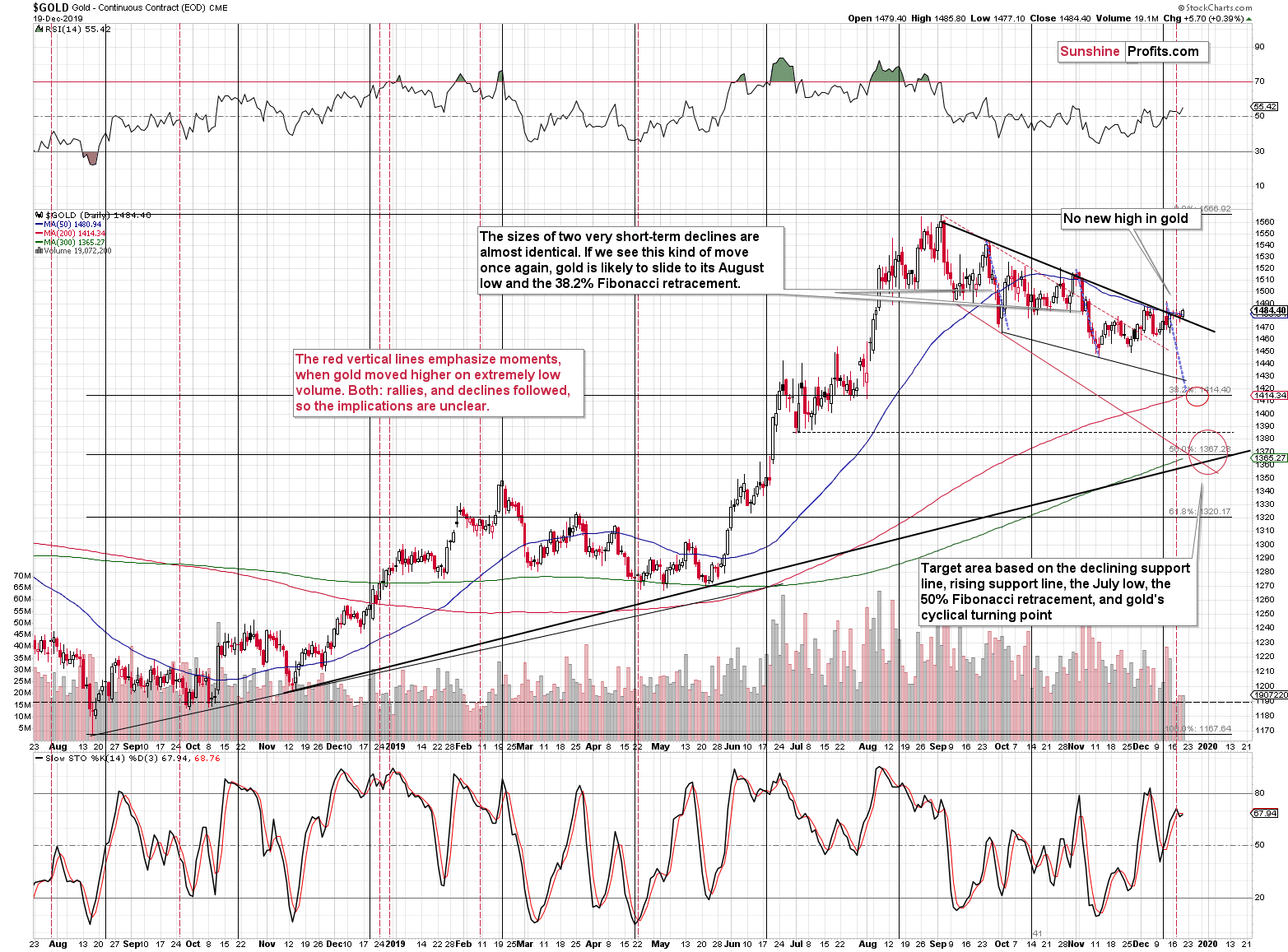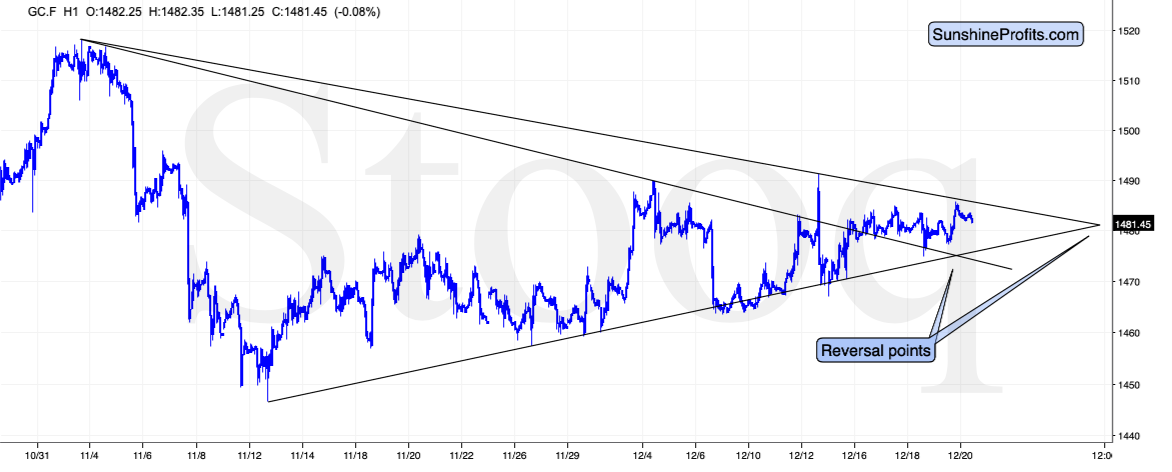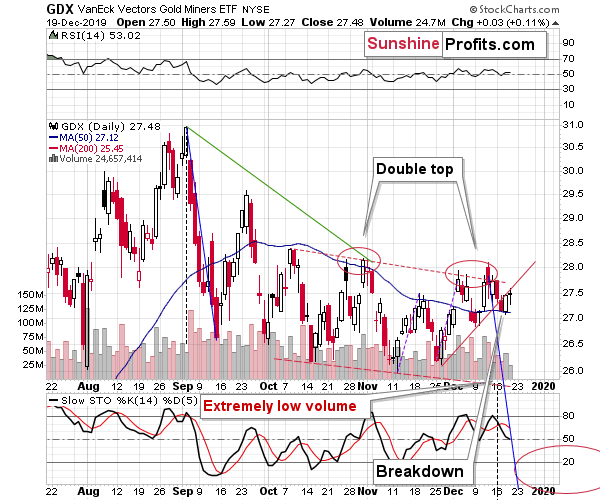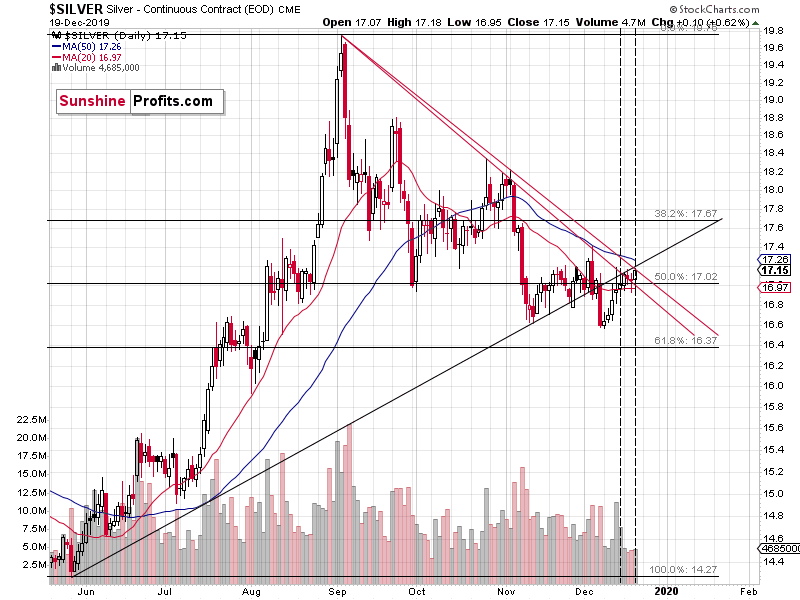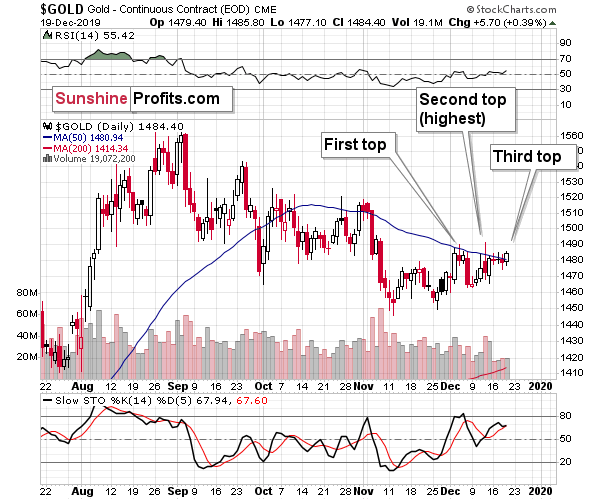Briefly: in our opinion, full (250% of the regular size of the position) speculative short position in gold, silver, and mining stocks is justified from the risk/reward point of view at the moment of publishing this Alert.
Our yesterday's analysis delved into the gold path in non-U.S. currencies, the lessons learned and the implications ahead. But didn't gold just throw a spanner in the works with its yesterday's upswing?
Gold's Twists and Turns
Gold just managed to close the day above the declining resistance line that's based on daily closing prices. This seems very bullish until one examines the volume at which the breakout took place. It was very low. This is exactly the opposite of what one wants to see as a breakout's confirmation. So why did gold rally?
Well, one reason could be a delayed reaction to U.S. President's impeachment news, but if so, then what caused the delay? That's where the technicals come in and there is one specific thing that causes this price action to make sense.
We just had a short-term triangle-vertex-based turning point in gold. If gold didn't rally before the reversal, it would have bullish implications. And the situation being what it is, we actually have bearish implications of what happened.
The existence of the reversal point, along with very weak volume on which gold moved higher yesterday, make it very likely that the move higher will be invalidated and followed by lower gold prices, not higher ones.
Speaking of low volume, let's take a look at the mining stocks.
The Miners' Moves
The volume was truly tiny. It was one of the lowest volume readings that we saw this year. And what did GDX do? It moved up by mere 3 cents. It was basically flat despite gold's breakout.
At the same time, GDX just confirmed its own breakdown by closing below the rising red support line for the third consecutive trading day. Miners are practically screaming here that gold's breakout was a fake move and that one shouldn't trust it.
The extremely low volume is also interesting on its own. The reason is that these sessions tend to imply that a lot of people are waiting on the sidelines, refusing to participate in the trading at all. This is important, because once the move - in any direction - starts, there are many people that can then join the trend as it matures. This means that the moves that follow the very low-volume sessions can be really sizable.
And what about silver?
Silver Throws Its Two Cents In
Silver confirms that it's time for a change in the short-term trend. Silver has been moving up for several days and it approached its two triangle-vertex-based reversals. Silver formed an intraday high almost right at the first of the reversals and it matched this high during yesterday's session. Silver also closed at a new very short-term high yesterday - it didn't move to a new December high, though.
Silver is moving lower today (at least at the moment of writing these words), which suggests that both reversals indeed worked.
Reversals plus low volume could equal a big move lower shortly. There's not much time for the decline to take place - probably next week - because of the current True Seasonal pattern and the long-term triangle-vertex-based reversals that we discussed previously.
The Seasonality's Perspective
Gold tends to move higher in the final quarter of the year, and if we consider the fact that gold closed September at $1,472.90, we see that it's been true at least so far. Based on the seasonal tendencies, the yellow metal was supposed to decline in November, and that's exactly what happened. Gold was supposed to then move higher and it did. It didn't move above the November high, though. That doesn't mean that the seasonality is useless - it simply means that since gold is now in a medium-term downtrend (considering highs, lows, and for instance the declining 50-day moving average), the implications might have a bit shifted, but they aren't necessarily totally absent.
The above chart suggests three tops in the head-and-shoulders form and that is indeed what gold formed.
What we just saw could have been the final of the three tops that is then likely (based on the seasonality alone) to be followed by the biggest decline of the quarter.
Now, taking seasonality at its face value, this is the time of the year when gold should be bottoming and preparing for its year-end rally. However, it seems that the patterns were delayed and since we have indications of upcoming reversals at the end of the year, it seems that we are still likely to see quite a volatile move lower before the next short-term corrective rally starts.
Naturally, the numerous other factors that we discussed previously continue to support lower precious metals prices in the following months. If you haven't read these analyses - especially the ones from the "critical" section, we strongly encourage you to do so. These are not quick reads, but they are really well worth the time spent reading them.
Key Factors to Keep in Mind
Critical factors:
- The USD Index broke above the very long-term resistance line and verified the breakout above it. Its huge upswing is already underway.
- The USD's long-term upswing is an extremely important and bearish factor for gold. There were only two similar cases in the past few decades, when USD Index was starting profound, long-term bull markets, and they were both accompanied by huge declines in gold and the rest of the precious metals market
- Out of these two similar cases, only one is very similar - the case when gold topped in February 1996. The similarity extends beyond gold's about a yearly delay in reaction to the USD's rally. Also the shape of gold price moves prior to the 1996 high and what we saw in the last couple of years is very similar, which confirm the analysis of the gold-USD link and the above-mentioned implications of USD Index's long-term breakout.
- The similarity between now and 1996 extends to silver and mining stocks - in other words, it goes beyond USD, gold-USD link, and gold itself. The white metal and its miners appear to be in a similar position as well, and the implications are particularly bearish for the miners. After their 1996 top, they erased more than 2/3rds of their prices.
- Many investors got excited by the gold-is-soaring theme in the last few months, but looking beyond the short-term moves, reveals that most of the precious metals sector didn't show substantial strength that would be really visible from the long-term perspective. Gold doesn't appear to be starting a new bull market here, but rather to be an exception from the rule.
- Gold stocks appear to be repeating their performance from 20 years ago, which means that a bottom in the entire precious metals sector is quite likely to form at much lower prices, in about a year
Very important, but not as critical factors:
- Long-term technical signs for silver, i.a. the analogy in terms of price to what we saw in 2008, shows that silver could slide even below $10.
- Silver's very long-term cycles point to a major reversal taking place right now and since the most recent move was up, the implications are bearish (this is also silver's technical sign, but it's so important that it deserves its own point)
- Long-term technical signs for gold stocks point to this not being a new gold bull market beginning. Among others, it's their long-term underperformance relative to gold that hint this is rather a corrective upswing within a bear market that is not over yet.
- Record-breaking weekly volume in gold is a strong sign pointing to lower gold prices
Important factors:
- Extreme volume reading in the SIL ETF (proxy for silver stocks) is an effective indication that lower values of silver miners are to be expected
- Silver's short-term outperformance of gold, and gold stocks' short-term underperformance of gold both confirm that the precious metals sector is topping here
- Gold topped almost right at its cyclical turning point, which makes the trend reversal more likely
- Copper broke below its head-and-shoulders pattern and confirmed the breakdown. The last time we saw something similar was in April 2013, when the entire precious metals sector was on the verge of plunging lower.
Moreover, please note that while there may be a recession threat, it doesn't mean that gold has to rally immediately. Both: recession and gold's multi-year rally could be many months away - comparing what happened to bond yields in the 90s confirms that.
Summary
Summing up, the short-term outlook for the precious metals sector is bearish for the next 1-1.5 weeks. It's quite likely (no promises, though, as it depends on what the market does) that we're going to take (partial or complete) profits from the current short position this month. We might also reverse the position and go long, but - as above - it's too early to say with certainty at this time. For now, it seems that the USDX is about to rally and the PMs are about to slide.
As always, we'll keep you - our subscribers - informed.
To summarize:
Trading capital (supplementary part of the portfolio; our opinion): Full speculative short position (250% of the full position) in gold, silver, and mining stocks is justified from the risk/reward perspective with the following stop-loss orders and binding exit profit-take price levels:
- Gold futures: profit-take exit price: $1,391; stop-loss: $1,573; initial target price for the DGLD ETN: $36.37; stop-loss for the DGLD ETN: $25.44
- Silver futures: profit-take exit price: $15.11; stop-loss: $19.06; initial target price for the DSLV ETN: $24.88; stop-loss for the DSLV ETN: $14.07
- Mining stocks (price levels for the GDX ETF): profit-take exit price: $23.21; stop-loss: $30.11; initial target price for the DUST ETF: $14.69; stop-loss for the DUST ETF $6.08
In case one wants to bet on junior mining stocks' prices, here are the stop-loss details and target prices:
- GDXJ ETF: profit-take exit price: $30.32; stop-loss: $44.22
- JDST ETF: profit-take exit price: $35.88 stop-loss: $11.68
Long-term capital (core part of the portfolio; our opinion): No positions (in other words: cash)
Insurance capital (core part of the portfolio; our opinion): Full position
Whether you already subscribed or not, we encourage you to find out how to make the most of our alerts and read our replies to the most common alert-and-gold-trading-related-questions.
Please note that the in the trading section we describe the situation for the day that the alert is posted. In other words, it we are writing about a speculative position, it means that it is up-to-date on the day it was posted. We are also featuring the initial target prices, so that you can decide whether keeping a position on a given day is something that is in tune with your approach (some moves are too small for medium-term traders and some might appear too big for day-traders).
Plus, you might want to read why our stop-loss orders are usually relatively far from the current price.
Please note that a full position doesn't mean using all of the capital for a given trade. You will find details on our thoughts on gold portfolio structuring in the Key Insights section on our website.
As a reminder - "initial target price" means exactly that - an "initial" one, it's not a price level at which we suggest closing positions. If this becomes the case (like it did in the previous trade) we will refer to these levels as levels of exit orders (exactly as we've done previously). Stop-loss levels, however, are naturally not "initial", but something that, in our opinion, might be entered as an order.
Since it is impossible to synchronize target prices and stop-loss levels for all the ETFs and ETNs with the main markets that we provide these levels for (gold, silver and mining stocks - the GDX ETF), the stop-loss levels and target prices for other ETNs and ETF (among other: UGLD, DGLD, USLV, DSLV, NUGT, DUST, JNUG, JDST) are provided as supplementary, and not as "final". This means that if a stop-loss or a target level is reached for any of the "additional instruments" (DGLD for instance), but not for the "main instrument" (gold in this case), we will view positions in both gold and DGLD as still open and the stop-loss for DGLD would have to be moved lower. On the other hand, if gold moves to a stop-loss level but DGLD doesn't, then we will view both positions (in gold and DGLD) as closed. In other words, since it's not possible to be 100% certain that each related instrument moves to a given level when the underlying instrument does, we can't provide levels that would be binding. The levels that we do provide are our best estimate of the levels that will correspond to the levels in the underlying assets, but it will be the underlying assets that one will need to focus on regarding the signs pointing to closing a given position or keeping it open. We might adjust the levels in the "additional instruments" without adjusting the levels in the "main instruments", which will simply mean that we have improved our estimation of these levels, not that we changed our outlook on the markets. We are already working on a tool that would update these levels on a daily basis for the most popular ETFs, ETNs and individual mining stocks.
Our preferred ways to invest in and to trade gold along with the reasoning can be found in the how to buy gold section. Additionally, our preferred ETFs and ETNs can be found in our Gold & Silver ETF Ranking.
As a reminder, Gold & Silver Trading Alerts are posted before or on each trading day (we usually post them before the opening bell, but we don't promise doing that each day). If there's anything urgent, we will send you an additional small alert before posting the main one.
Thank you.
Sincerely,
Przemyslaw Radomski, CFA
Editor-in-chief, Gold & Silver Fund Manager


